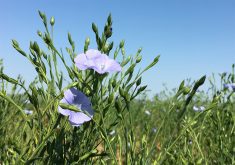North American demand | More fields of blue may be seen in Alberta
Go west, old crops.
That’s the advice the markets have given to flax and could begin whispering to oats, says analyst Chuck Penner.
Canadian flax acreage went from being 80 percent in Manitoba in 1976 to 80 percent in Saskatchewan by 2006. The trend is unlikely to stop at the Alberta-Saskatchewan border.
“I submit that you’ll see it move further west,” Penner told the recent Canada Grains Council annual meeting. “You’ll see more in Alberta.”
Penner said shifting markets will likely result in substantial flax acreage in Alberta and continued low area in Manitoba. The crop was once shipped almost entirely to Europe, making proximity to Thunder Bay the dominant influence on relative prairie prices. The further east, the better the price.
Read Also

No special crop fireworks expected
farmers should not expect fireworks in the special crops market due to ample supplies.
That has shifted in recent years, and buyers are now more diverse, including substantial demand from North America.
The discovery of a genetically modified variety in shipments to Europe, which closed that market, dramatically increased the relative price shift.
As well, China’s rise as a significant buyer suddenly reversed the traditional spread of relative prices on the Prairies, often making it better to grow flax far west of Manitoba.
Penner said there’s potential for oats to do the same thing.
China now buys little Canadian oats, but there’s no reason it might not start buying some, he added.
“I think maybe we can take oats and move it to China the way we developed peas and move flax,” he said.
“If they can use it as a food ingredient, as a food component, if they can use it for even a small share of what they’re doing, what would that do in terms of total demand for oats?”
Penner said farmers switch acres according to price signals, but not in the short run. They need to see a trend develop before embracing it. Blips and aberrations in the market don’t cause permanent shifts, but lasting price movements do.
Corn and soybean acreage has increased in Manitoba and other warm parts of the Prairies, but he thinks the growth won’t continue unabated.
At some point, those crops’ vulnerability to prairie weather will cause farmers to reappraise them.
“Eventually it’ll stop … once we have a couple of frost wrecks a couple of years in a row.”
Penner said big crops will continue to stay big in acreage.
Wheat will remain dominant if GM varieties are introduced that are substantially better.
Canola acreage will also remain strong, but probably less will be marketed to the United States. American farmers are already growing substantial acreages in non-traditional places such as Oklahoma, and that trend might develop further, meeting more U.S. demand.
Special crop prices will become even more volatile as they compete with the big crops for acreage.
“They’ll face increasing pressure to buy acres.”
















